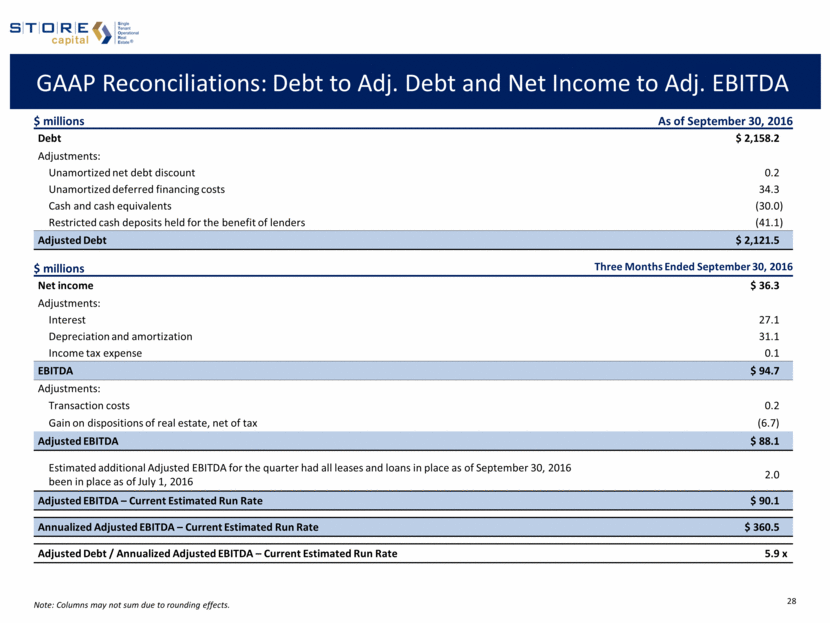Attached files
| file | filename |
|---|---|
| 8-K - 8-K - STORE CAPITAL Corp | a16-21385_18k.htm |
Exhibit 99.1
2016 Third Quarter Presentation November 2016 The LEADER in Middle Market Real Estate Capital Solutions SINGLE TENANT OPERATIONAL REAL ESTATE
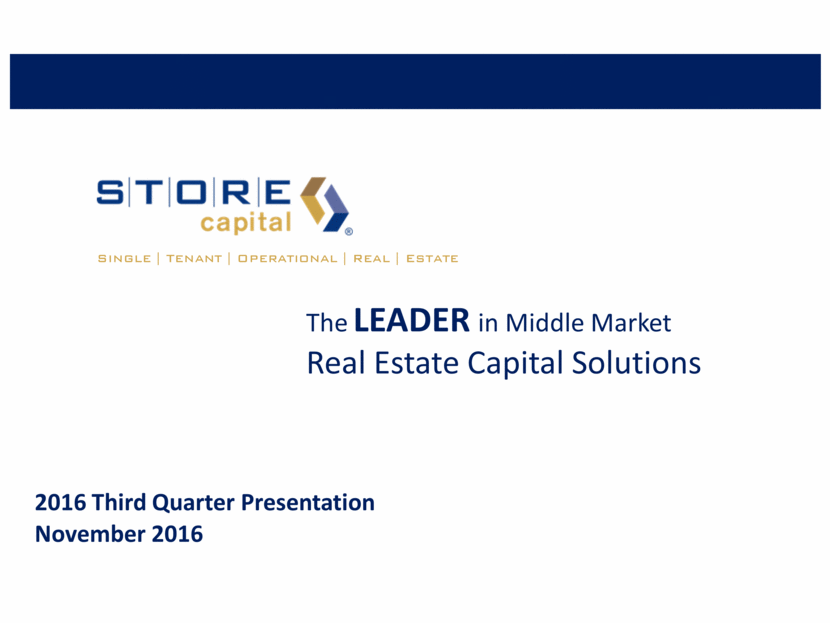
Disclaimer This presentation includes forward-looking statements within the meaning of Section 27A of the Securities Act of 1933, as amended, that are subject to the “safe harbor” created by that section. These forward-looking statements include comments with respect to our objectives and strategies, and the results of our operations and our business. Forward-looking statements can be identified by the fact that they do not relate strictly to historical or current facts. They often include words such as “expects,” “assumes,” “anticipates,” “intends,” “plans,” “believes,” “seeks,” “estimates” or words of similar meaning, or future or conditional words such as “assuming,” “will,” “would,” “possible,” “proposed,” “projected,” “positioned,” “vision,” “opportunity,” “should,” “could,” “indicative,” “target” or “may.” FORWARD-LOOKING STATEMENTS INVOLVE NUMEROUS RISKS AND UNCERTAINTIES, AND YOU SHOULD NOT RELY ON THEM AS PREDICTIONS OF FUTURE EVENTS. FORWARD-LOOKING STATEMENTS DEPEND ON ASSUMPTIONS, DATA OR METHODS THAT MAY BE INCORRECT OR IMPRECISE, AND WE MAY NOT BE ABLE TO REALIZE THEM. WE DO NOT GUARANTEE THAT THE TRANSACTIONS AND EVENTS DESCRIBED WILL HAPPEN AS DESCRIBED (OR THAT THEY WILL HAPPEN AT ALL). THE FOLLOWING FACTORS, AMONG OTHERS, COULD CAUSE ACTUAL RESULTS AND FUTURE EVENTS TO DIFFER MATERIALLY FROM THOSE SET FORTH OR CONTEMPLATED IN any FORWARD-LOOKING STATEMENT made in this presentation: general business and economic conditions; continued volatility and uncertainty in the credit markets and broader financial markets, including potential fluctuations in the consumer price index; other risks inherent in the real estate business, including tenant defaults, potential liability relating to environmental matters, illiquidity of real estate investments, and potential damages from natural disasters; availability of suitable properties to acquire and our ability to acquire and lease those properties on favorable terms; ability to renew leases, lease vacant space or re-lease space as existing leases expire or are terminated; the degree and nature of our competition; our failure to generate sufficient cash flows to service our outstanding indebtedness; access to debt and equity capital markets; fluctuating interest rates; availability of qualified personnel and our ability to retain our key management personnel; changes in, or the failure or inability to comply with, government regulation, including Maryland laws; failure to maintain our status as a REIT; changes in the U.S. tax law and other U.S. laws, whether or not specific to REITs; and the risks described in the Company’s Annual Report on Form 10-K for the fiscal year ended December 31, 2015 and subsequent Quarterly Reports on Form 10-Q. This presentation contains references to our copyrights, trademarks and service marks and to those belonging to other entities. Solely for convenience, copyrights, trademarks, trade names and service marks referred to in this presentation may appear without the © or ® or TM or SM symbols, but such references are not intended to indicate, in any way, that we will not assert, to the fullest extent under applicable law, our rights or the rights of the applicable licensor to these copyrights, trademarks, trade names and service marks. We do not intend our use or display of other companies’ trade names, copyrights, trademarks or service marks to imply a relationship with, or endorsement or sponsorship of us by, any other companies.
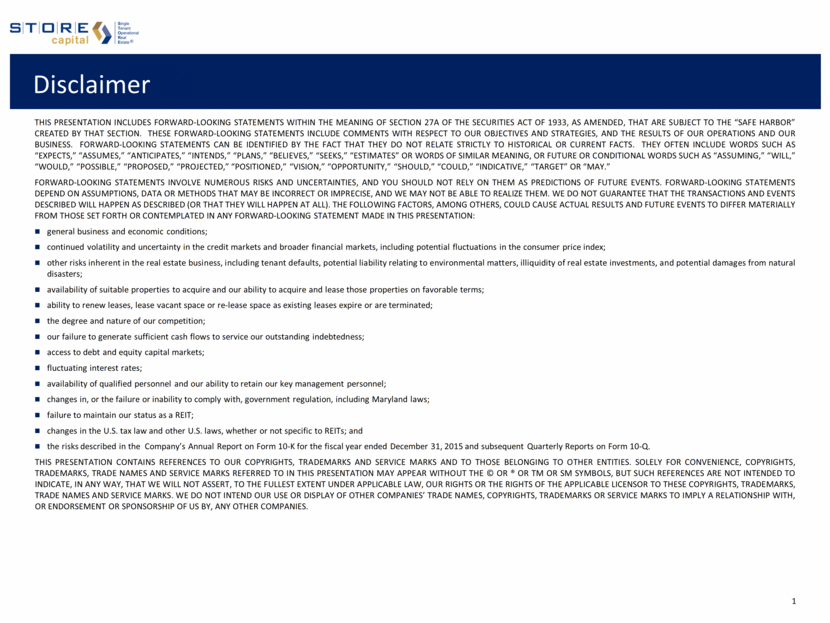
STORE Overview STORE is Single Tenant Operational Real Estate The leader in middle market net-lease solutions: S T O R E is the nation’s only REIT dedicated to profit center real estate investment, with a focus on middle market and larger companies. A $2.5 trillion market for single-tenant “profit center” real estate: We have a $7.7 billion pipeline1 of potential targeted investments. One of the fastest growing net-lease REITs in the US: We have invested more than $4.8 billion since our organization in 2011 with current annualized base rent and interest of over $395 million. High quality portfolio subject to long-term leases: S T O R E believes that, on average, approximately 75% of contracts are equivalent to investment grade (internal S T O R E rating of Baa3 or above). Efficient capital structure: We are one of very few REITs to have both an A+ rated debt conduit and corporate investment-grade credit ratings. Scalable platform positioned for growth: We have market-leading external and internal growth. Data as of September 30, 2016. 1 S T O R E’s pipeline as of September 30, 2016. See slide 7 for more information about S T O R E's pipeline, including its composition. S T O R E may never acquire properties in its pipeline for a variety of reasons as described in the Company’s Annual Report on Form 10-K for the year ended December 31, 2015.
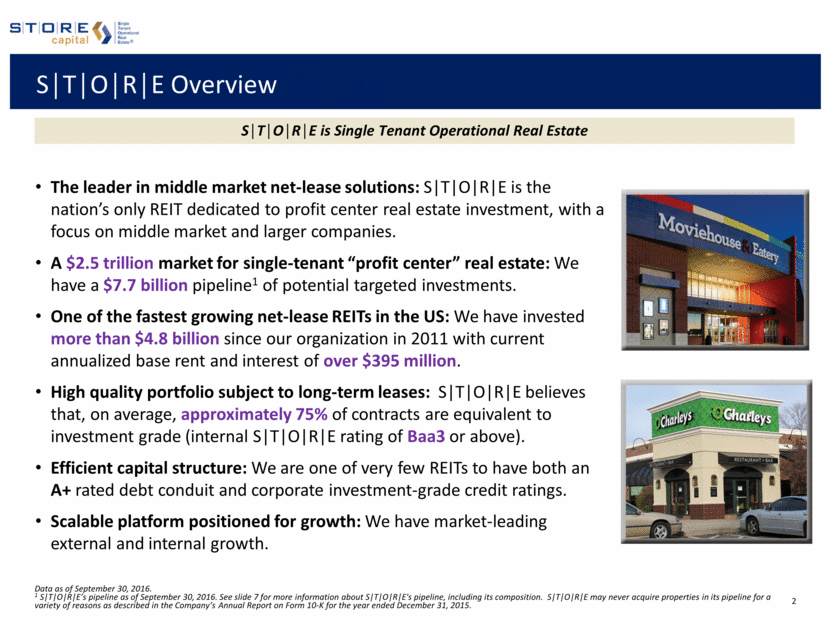
STORE’s Key 2016 Achievements Generated a total return to shareholders of 19.7% during 2016, versus 0.6% for the MSCI U.S. REIT Index1 Invested nearly $900 million year-to-date (YTD) in 2016 at an initial weighted average cap rate of 8.0%2 Grew our YTD 2016 comparable revenues by 33.7% and Adjusted Funds from Operations (AFFO) by 36.5% Grew our YTD 2016 comparable AFFO per share by 11.0% Increased our pipeline of potential targeted investments to approximately $7.7 billion3 Grew to over 1,575 properties leased to nearly 340 customers across 100 industry groups4 Added a corporate BBB-, Positive Outlook, credit rating from Standard & Poor’s Ratings Services Employed our complimentary A+ rated conduit to issue $200 million of ten-year, fixed-rate notes at 3.96% Increased our dividend 7.4% while maintaining our dividend protection Established a $400 million ATM program in September 2016, increasing our growth equity access efficiency Maintained approximately 75% of our net-lease contracts investment-grade in quality 1 Source: Bloomberg. Represents total return over period from January 1, 2016 through October 28, 2016. Past performance is not necessarily an indicator of our future performance. 2 Represents acquisitions of real estate and investment in loans receivable between January 1, 2016 and September 30, 2016. 3 S T O R E’s pipeline as of September 30, 2016. See slide 7 for more information about S T O R E's pipeline, including its composition. S T O R E may never acquire properties in its pipeline for a variety of reasons as described in the Company’s Annual Report on Form 10-K for the fiscal year ended December 31, 2015. 4 As of September 30, 2016.

Experienced Leadership Team with a Proven Track Record Management team with 35-year track record More than $14.4 billion invested in 8,900+ STORE assets Investor returns in management’s prior investment vehicles have outperformed benchmarks1 Guided the formation, and ultimate sale, of two successful NYSE-listed REITs: Franchise Finance Corporation of America (FFCA)(NYSE: FFA) and Spirit Finance (NYSE: SFC) FFCA Spirit Finance 17 Privately Traded Funds (16 SEC Registered) STORE Spirit Finance sold FFCA sold Data as of September 30, 2016. 1 Prior performance is not necessarily an indicator of future performance, and S T O R E’s future returns may not exceed industry benchmarks. We believe we have originated more single-tenant operational real estate investments than anyone 1981 – 2016 investment activity ($MM)1
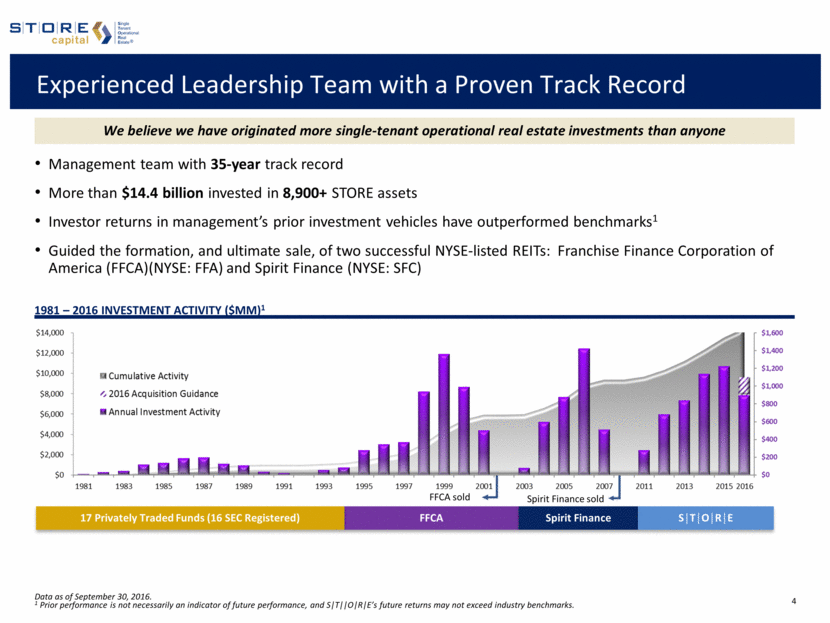
Target Market Exceeding $2.5 Trillion in Size Large More than $2.5 trillion of STORE properties in the United States STORE has a $7.7 billion pipeline of potential targeted investments1 Diverse Highly fragmented More than 1.6 million properties Underserved STORE focuses on larger, unrated bank-dependent companies Underserved by the market Regulatory rules discourage participation by traditional banks Market Overview STORE’s Target Market Source: SNL Financial, Morningstar, Company Data, Industry Specific Associations 1 S T O R E’s pipeline as of September 30, 2016. See slide 7 for more information about S T O R E's pipeline, including its composition. S T O R E may never acquire properties in its pipeline for a variety of reasons as described in the Company’s Annual Report on Form 10-K for the fiscal year ended December 31, 2015. 2 Triple Net Lease REITs include Agree Realty Corporation; EPR Properties; Gramercy Property Trust; Lexington Realty Trust; National Retail Properties, Inc.; Realty Income Corporation; Select Income REIT; Spirit Realty Capital, Inc.; VEREIT, Inc.; and W. P. Carey Inc. Represents enterprise value of those companies as of September 30, 2016, per SNL Financial. Small Companies Middle Market Companies Large Companies Rated Companies STORE’s Target market Available $2.5 Trillion STORE Property Market Public Triple Net Service Retail Industrial Lease REITs2 47.0% 37.0% 16.0% 3.8% Our target market is the largest commercial real estate sector not represented by institutional capital Total Target Market
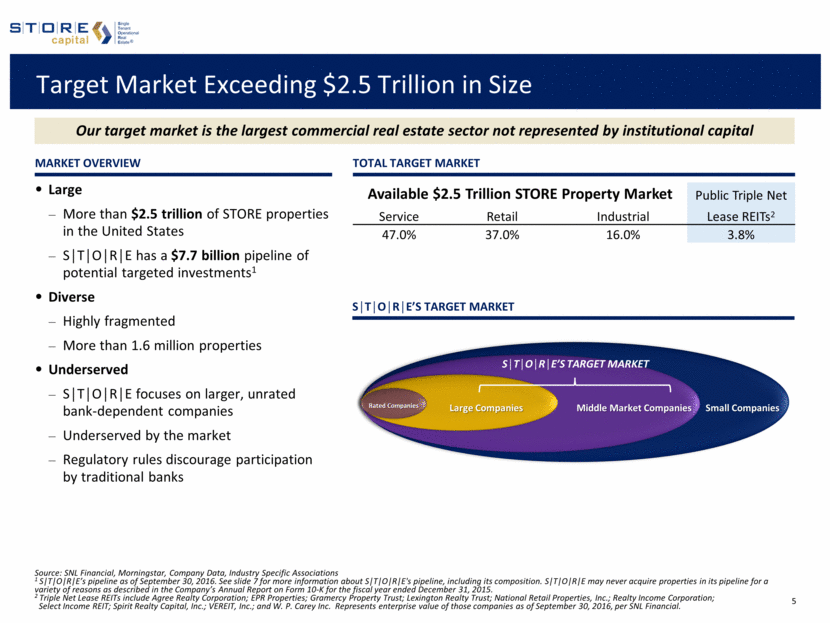
Superior Origination Platform Deal flow ownership and lease contract creation designed to allow us to generate higher yields Direct calling efforts on thousands of companies and financial sponsors Deal Flow Ownership Tenant introductions through real estate broker relationships Virtual Salesforce >75% <25% OUR NET-LEASE PRICING ADVANTAGE1 Source: Company data as of September 30, 2016. 1 Represents the sales cap rate achieved on opportunistic property sales during 2016 as compared to the initial weighted average cap rate on 2016 acquisitions. 1.0% 7.0% 8.0% 5.0% 5.5% 6.0% 6.5% 7.0% 7.5% 8.0% 8.5% 9.0% Wtd. Avg. Opportunistic Sales Cap 2016 S T O R E Wtd. Avg. Cap Rate 2016
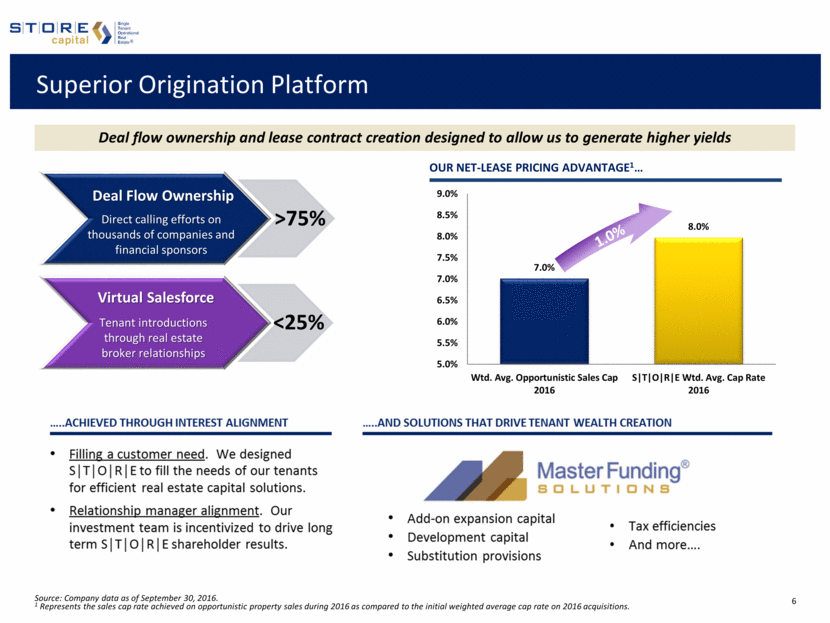
Pipeline Sector Distribution as of september 30, 2016 We Have a $7.7 Billion Pipeline of Potential Investments STORE’s pipeline remains robust LOI Signed ($454 MM) Pipeline Stages (SINCE INCEPTION) New Opportunity ($4.0 billion) Investment Opportunities 32% Letter of Intent Sent 13% Letter of Intent Executed 8% Approved 6.2% Contract Executed 6.0% Close 50% Actionable Opportunities $7.7 billion total pipeline as of September 30, 2016¹ ¹ Data as of September 30, 2016. S T O R E may never acquire properties in its pipeline for a variety of reasons, including the discovery of previously unknown liabilities or other items uncovered during its diligence process, unsuccessful negotiations with potential sellers and the failure of closing conditions to be satisfied. In addition, the pipeline is dynamic, and its size and composition, as well as the timing and probability of investment closing, are likely to vary substantially over time. Accordingly, you should not place undue reliance on the pipeline disclosures in this presentation. Storage 3% Spec. Med. 7% STORE is selective, closing ~6% of all identified opportunities Restaurant 21% Manufacturing 13% Theaters 6% Other 11% Retail 21% Entertainment 9% Education 4% Gyms 5%
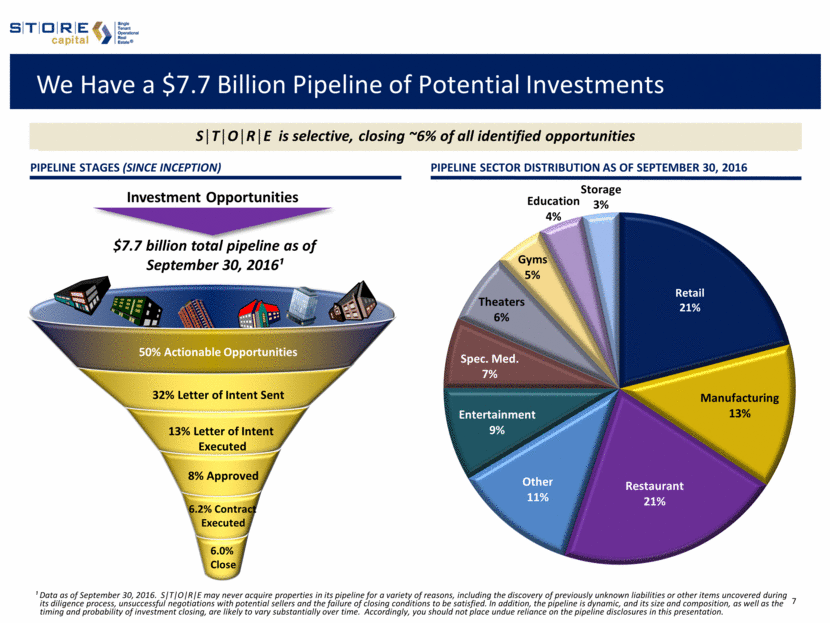
STORE Contracts vs. Investment Grade Tenant Leases TYPICAL LEASE STRUCTURE FOR SELECT COMPANIES vs. STORE Tenant credit ratings are transient and only one payment source Over 15 years, half of investment-grade companies lose their investment-grade ratings1 Contracts can encompass more permanent characteristics Investment-grade profit-center contracts provide the following: Source: Company filings, CoStar, Standard & Poor’s Ratings Services 1 “2013 Annual Global Corporate Default Study and Ratings Transitions”, Standard & Poor’s Ratings Services 2 CoStar as of October 27, 2016 (prior 18 month average for reported transactions). 3 Home Depot comparative $/PSF represents average of S T O R E’s electronic, furniture and home goods stores. LA Fitness comparative $/PSF represents average of S T O R E’s fitness centers. Walgreens comparative $/PSF represents average of S T O R E s urgent care centers and drugstores. Dollar General comparative value represents average of S T O R E’s dollar stores. The comparability of the assets is not necessarily an indicator of future results and assets may not be fully comparable as a result of S T O R E ’s sample size and market or locational differences. Data as of September 30, 2016. A BB tenant with a strong contract is generally equal to or better than an investment-grade tenant with a weak contract Feature Importance Rational investment amounts Lower investment risk Master leases & cross-defaults Alignment & investment diversity Unit-level reporting Site & payment stream quality indication Home Depot LA Fitness Walgreen’s Dollar General STORE Rent Bumps Unit Level Reporting Master Lease/ Cross Default Triple Net Avg. $/PSF2 $164 $342 $442 $152 STORE Comparatives3 $98 $166 $318 $96 Our investment portfolio is comprised of approximately 75% investment-grade contracts CONTRACTS GOVERN RISK
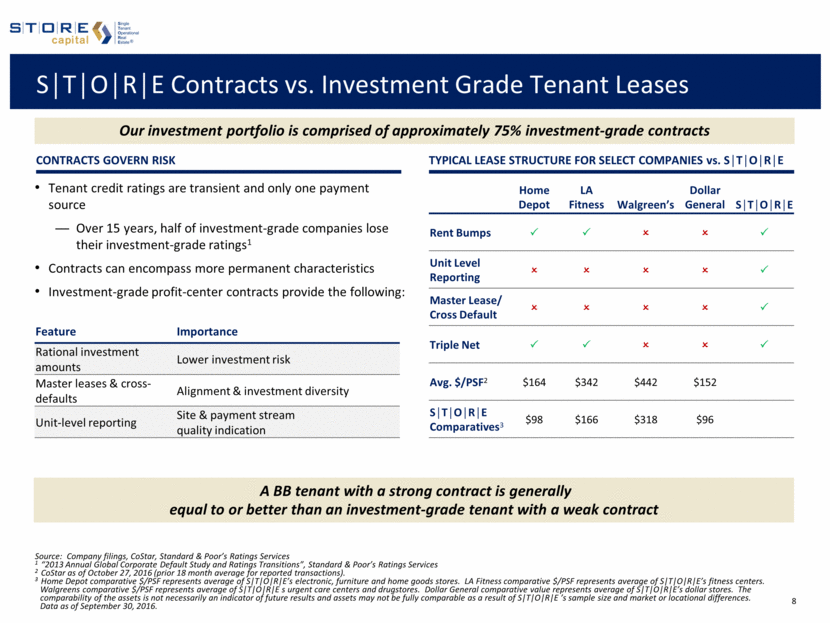
Portfolio Contract Quality Expected default frequency & STORE score equivalent Ratings Data as of September 30, 2016. We measure the credit quality of our portfolio on a contract-by-contract basis using the STORE Score, which is a risk measure reflective of both the credit risk of our tenants and the profitability of the operations at our properties. The STORE Score is a quantitative measurement of contract risk computed by multiplying tenant default probabilities (using Moody’s RiskCalc) and estimated store closure probabilities (using a simple algorithm we developed that has closure probabilities ranging from 100% to 10%, depending on unit-level profitability). Qualitative features can also impact investment risk, such as low property investment amounts, favorable tenant debt capital stacks, the presence of third party guarantors, or other factors. Such qualitative factors may serve to further mitigate investment risk. We have maintained lease contract quality, averaging approximately 75% investment-grade.
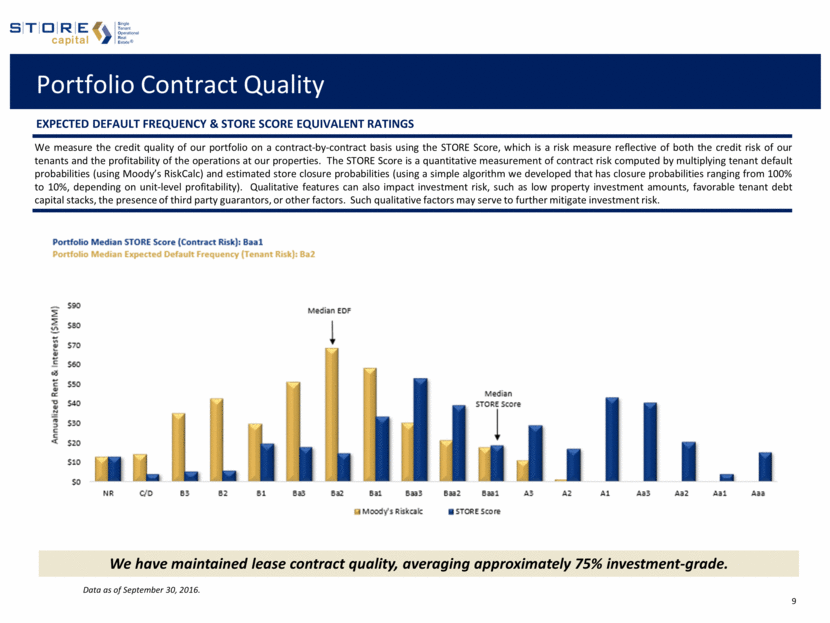
Portfolio – At a Glance OUR PORTFOLIO as of September 30, 2016 Investment Property Locations 1,576 Customers 337 Industries in which our Customers Operate 100 States 48 Proportion of Portfolio from Direct Origination ~75% % of Investment Portfolio subject to STORE preferred contract terms * 90% Weighted Average Annual Lease Escalation1 1.7% Weighted Average Remaining Lease Contract Term ~14 Years Occupancy2 99.2% # of Properties not currently operating but subject to a Lease3 6 # of Investment Locations subject to a Ground Lease 16 % of Investment Portfolio subject to NNN Leases * 97% % of Investment Portfolio subject to Master Leases * 4 80% Average Investment Amount / Replacement Cost (new) 5 82% % of Investment Locations with Unit-Level Financial Reporting Requirements 97% Median Unit Fixed Charge Coverage Ratio (FCCR)/4-Wall Coverage Ratio6 2.10x/2.62x Proportion of Investment Contracts Rated Investment Grade7 ~75% *Based on annualized base rent and interest. Note: See page 23 for the definitions and numerical footnotes referenced above.
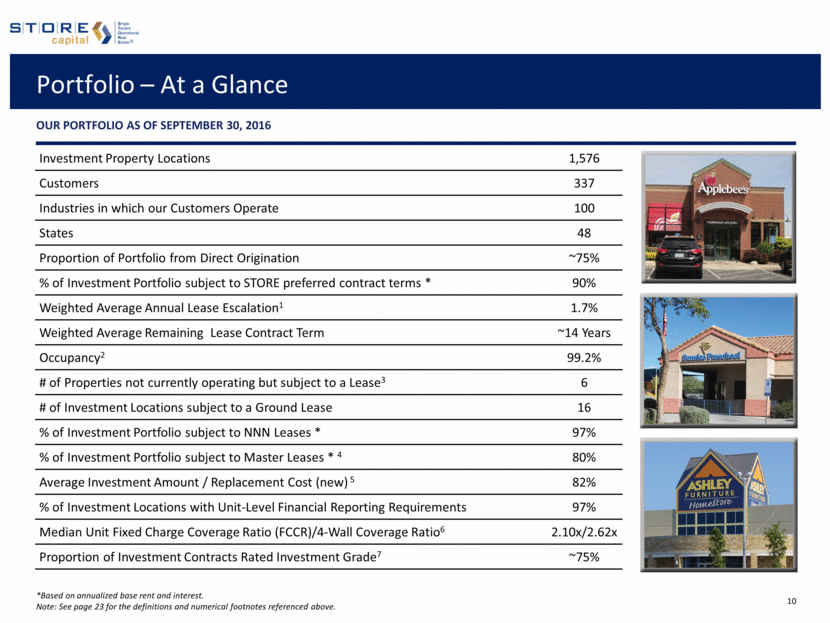
Diversified Across Geographies¹ Now in 48 states, with expected national distribution 1 Shown as of September 30, 2016 by % of annualized base rent and interest.
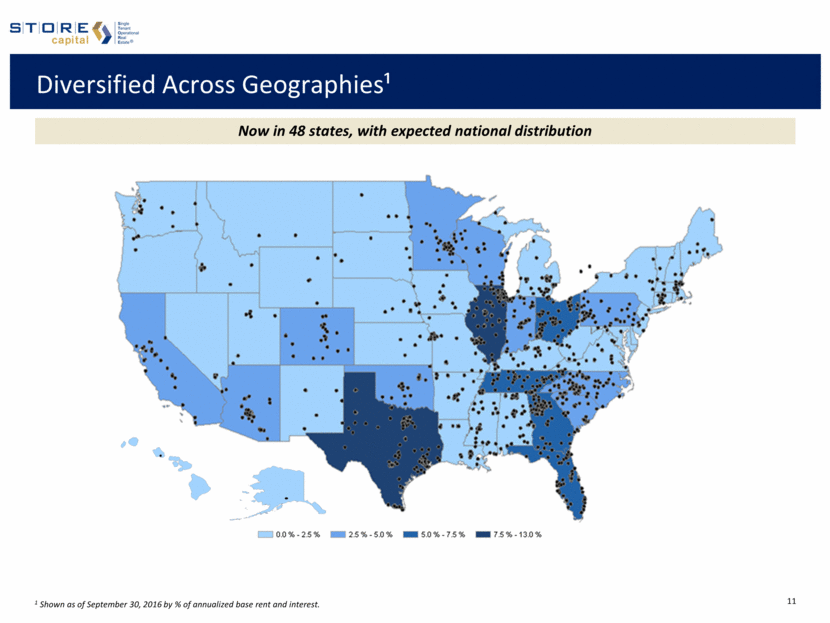
Diversification Across Customers Focus on industries with sustained relevance 1 Excludes customers, representing approximately 3.9% of annualized base rent and interest, that do not report corporate revenues. 2 Shown as of September 30, 2016, by % of annualized base rent and interest (annualized based on rates in effect on September 30, 2016, for all leases, loans and direct financing receivables in place as of that date). Diverse customer base of established, middle-market companies
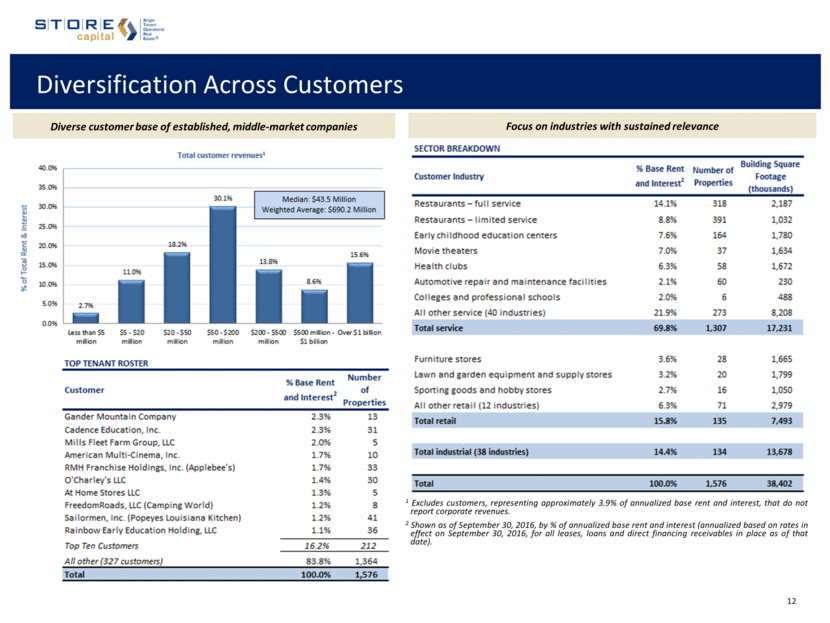
High Quality Portfolio Most Diversified Tenant Base Source: Latest publicly available financial information as of September 30, 2016. ¹ Includes: Agree Realty Corporation; EPR Properties; Lexington Realty Trust; Spirit Realty Capital, Inc.; VEREIT, Inc.; and W. P. Carey Inc. (weighted average lease term in years) Longest Lease Term Lowest Near-Term Renewal Exposure (% top 5 tenants, based on current annual rent) (% expirations by period, based on current annual rent) Our net-lease portfolio has long contract terms and very high tenant diversification
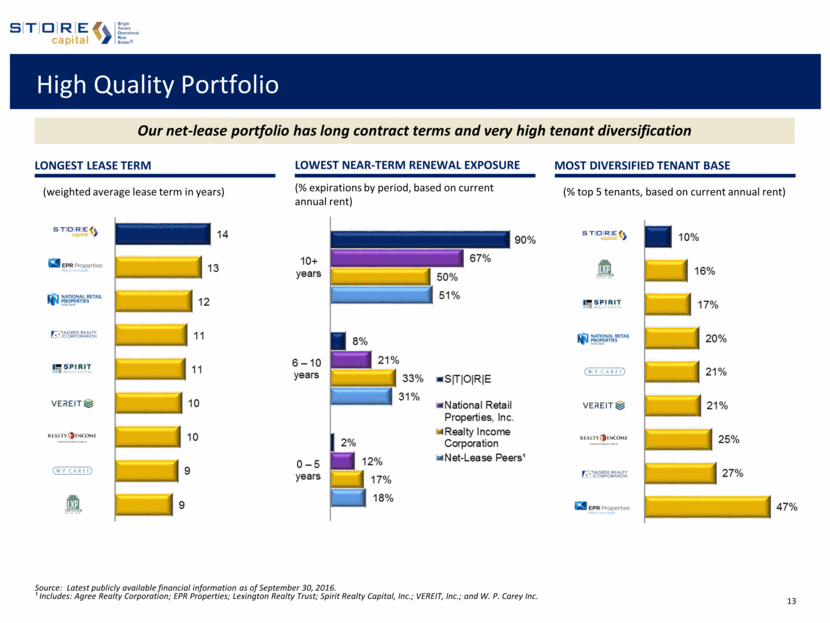
Stable and Growing Cash Flow Average Lease escalator2 Source: Latest publicly available quarterly financial statements as of September 30, 2016. ¹ Represents Adjusted EBITDA to Total Revenue. 2 See page 23 footnote 1 for description of STORE’s weighted average annual lease escalation. SRC and VEREIT data per historical numbers, not forward-looking data. (based on Q3 2016 financials) ebitda margin1 affo payout ratio (avg. stated lease escalator or most recent quarter same store NOI growth) (based on Q3 2016 financials) Our lease contracts and well-protected dividends provide cash flow growth and stability
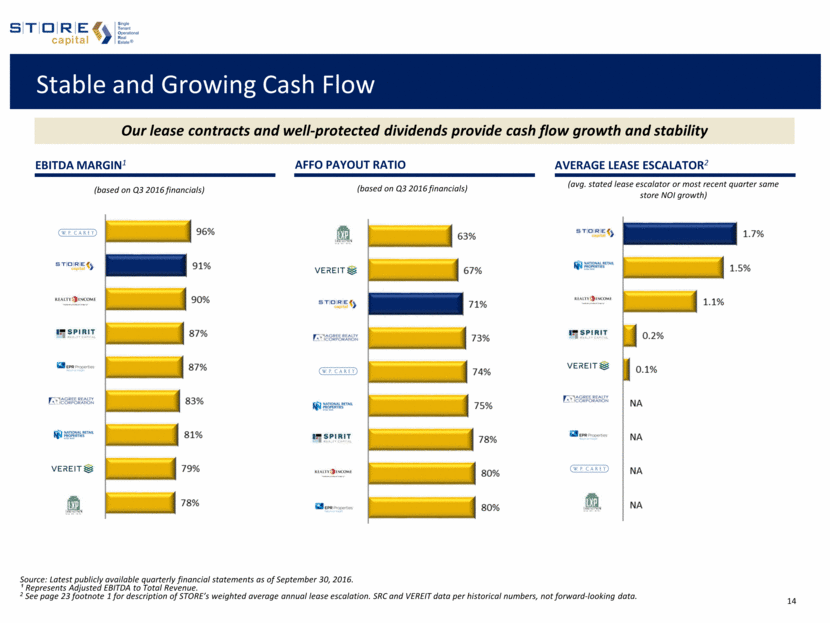
Flexible, Conservative Capital Structure Data as of September 30, 2016. 1Represents weighted average coupon rate as of September 30, 2016. For floating rate debt swapped to a fixed rate, the fixed rate is shown. 2 The credit facility is expandable up to $800 million. 3The BBB Rated Master Funding Conduit Notes are eliminated in consolidation. 4Excludes non-permanent debt such as our unsecured revolving credit facility. 5Represents Adjusted Debt / Annualized Adjusted EBITDA calculated based on an estimated Annualized Adjusted EBITDA using base rent and interest, annualized based on rates in effect on September 30, 2016 for all leases, loans and direct financing receivables in place as of that date. This reported figure has many important limitations, and you should not unduly rely on it. Please see Appendix for a description of these limitations and a reconciliation of adjusted debt and EBITDA to their most comparable GAAP measures. We have an A+ rated debt conduit, BBB- corporate credit ratings and industry-leading capital flexibility Multiple sources of Debt Balance Sheet highlights as of September 30, 2016 WELL-Laddered LONG-TERM Debt MATURITies4 ($MM) LIQUIDITY Cash & Cash Equivalents $30 Undrawn Credit Facility 455 Total Liquidity $485 UNENCUMBERED ASSETS Unencumbered Investment Portfolio Assets $2,281 BBB Master Funding Conduit Notes3 108 Total Unencumbered Assets $2,389 LONG-TERM BORROWINGS Term Unsecured Borrowings $475 Term Secured Borrowings 1,673 Total Long-Term Borrowings $2,148 We maintain a flexible, conservative capital structure Target all-in funded debt/EBITDA of 5.75-6.25x Adjusted Debt / Annualized Adjusted EBITDA – Current Estimated Run Rate5: 5.9x # Loan Amount ($MM) Avg. Rate 1 Maturity Unsecured Credit Facility 1 Up to $500 2 LIBOR + 1.35-2.15% Sept. 2019 Unsecured BBB- Notes Payable 3 375 $ 4.91% 2022-2026 Unsecured Term Loan Payable 1 100 $ 2.73% 2021 Master Funding A+ Rated Conduit 11 1,422 $ 4.65% 2019-2025 CMBS 13 211 $ 4.93% 2017-2038 Banks 4 34 $ 4.95% 2018-2020 Insurance Companies 5 6 $ 4.50% 2038 2,148 $
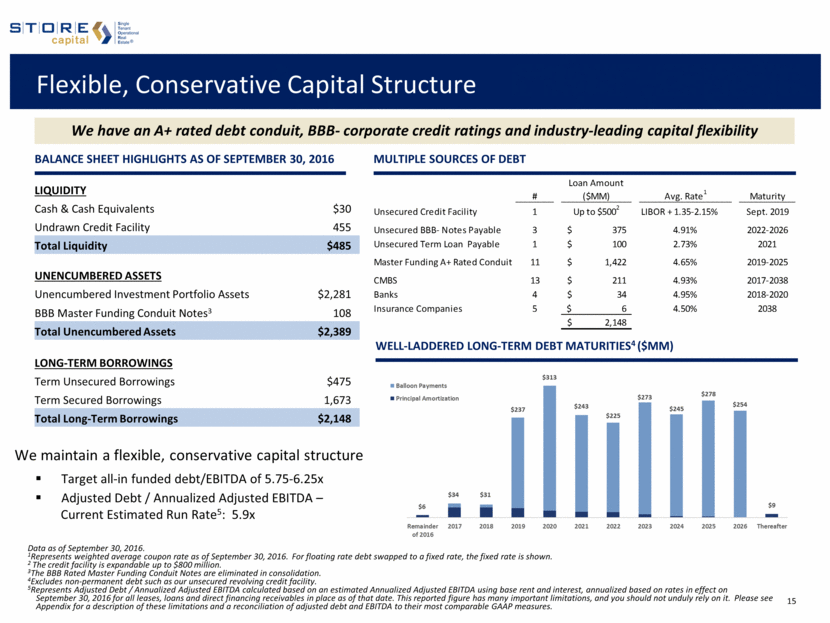
Prudent Leverage Philosophy and Access to Varied Borrowings A+ Master Funding BBB- Unsecured Notes Greater Access to Capital at a Low Cost ü ü Flexible Asset Management ü ü Differentiated Investor Base ü ü Ability to Re-Lever ü ü Source: SEC company filings. Data as of September 30, 2016. 1 Excludes non-permanent debt such as revolving credit facilities and lines of credit. 2 Weighted average figures calculated using reported data. Where a range of maturities is reported for a given tranche of debt, calculation uses latest maturity specified for that tranche. Cost of fixed rate debt includes preferred equity. Go long Be judicious Ladder debt maturities Be mindful of investment and debt yield mean reversion Use the three means of interest rate risk mitigation Lease escalations Free cash flow levels Secured debt principal paydowns STORE has broad access to investment-grade borrowings Market-leading balance sheet flexibility Our Borrowing Spread Philosophy Our Cost of Fixed rate Debt vs. KEY Peers Our LONG-TERM Debt MATURITY vs. KEY Peers1
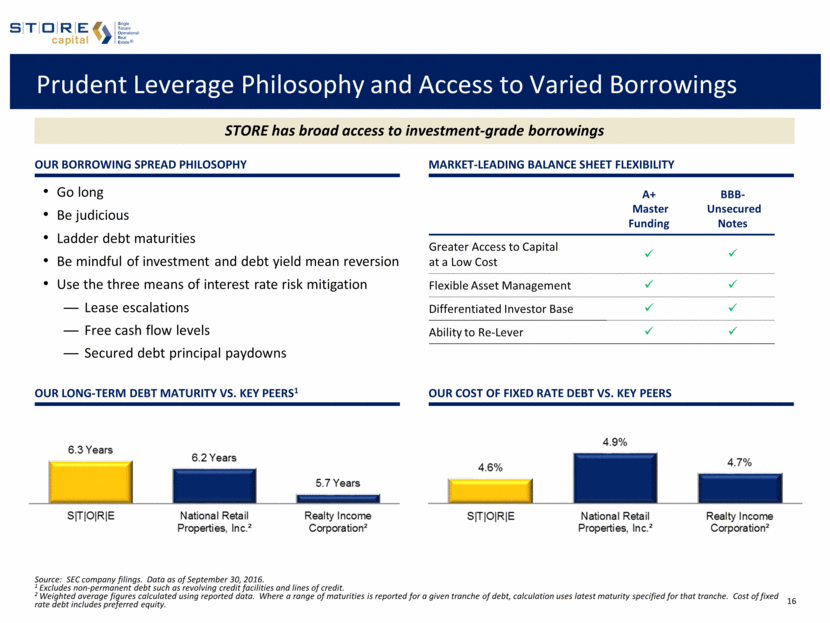
STORE’s History of Growth and Performance 1 Represents acquisitions of real estate and investment in loan and direct financing receivables. 2 Refer to Appendix for definitions of these non-GAAP financial measures and reconciliation to GAAP net income. 3 Gross Return represents initial cap rate plus weighted average annual lease escalators. Gross returns do not represent the actual returns we may earn on properties. STORE is a growth REIT with a scalable platform, financial flexibility and favorable investment returns Cap Rates, Gross Returns3 & Borrowing Costs UNENCUMBERED ASSETS ($mm) NOI and AFFO ($MM)2 Annual Acquisitions ($MM)1
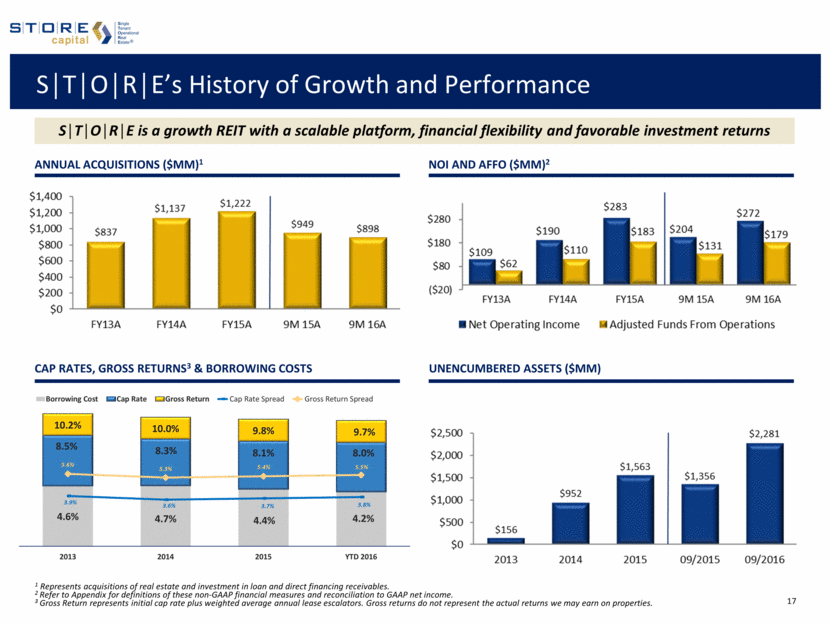
Our Dividend Policy and Growth Dividend policy We have a current annualized dividend rate of $1.16 per share Our dividend represents a 4.3% yield1 We have a stated target AFFO payout ratio of 65% – 75% Our dividend payout ratio is amongst the lowest of net-lease peer companies TARGET Internal AFFO per share Growth OF 3% TO 5% External growth is expected to be the driver of AFFO growth Driven by expected new investment activities that are high relative to our asset base, Backed by a strong $7.7 billion pipeline of potential investments2, Backed by a well-staffed origination platform, And driven by historically favorable investment spreads. 1 Based on closing stock price as of October 28, 2016. 2 As of September 30, 2016. See slide 7 for more information about S T O R E’s pipeline, including its composition. S T O R E may never acquire properties in its pipeline for a variety of reasons as described in the Company’s Annual Report on Form 10-K for the fiscal year ended December 31, 2015. 3 Shown as of September 30, 2016, by % of annualized base rent and interest (annualized based on rates in effect on September 30, 2016, for all leases, loans and direct financing receivables in place as of that date). Excludes leases, representing less than 0.3% in annualized base rent and interest, where the tenant does not have any further options to extend the lease and no remaining rent escalations. 4 Represents the weighted average annual escalation rate of the entire portfolio as if all escalations occurred annually. For escalations based on a formula including CPI, assumes the stated fixed percentage in the contract or assumes 1.5% if no fixed percentage is in the contract. For contracts with no escalations remaining in the current lease term, assumes the escalation in the extension term. External AFFO per share Growth Our internal growth is driven by attractive average annual lease escalations of 1.7%, And also by our low dividend payout ratio that is designed to permit added portfolio investments.
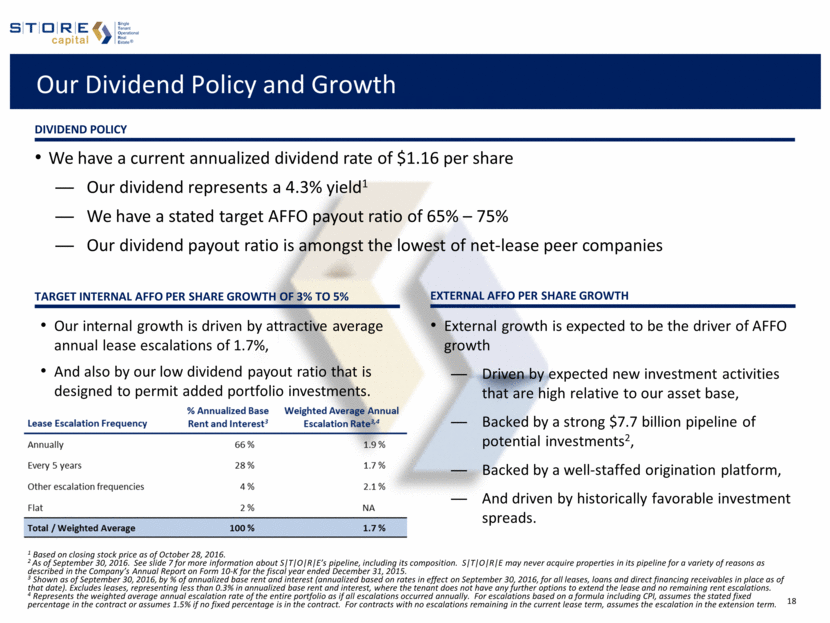
STORE is a Highly Compelling Risk-Adjusted Return Story Historical EPS Growth² >15.0% 11 50 Historical Dividend Yield >4.0% Source: SEC company filings, S&P Capital IQ. Data of November 4, 2016. ¹ Ratios are calculated as: share price / 2015A AFFO per share, divided by the sum of (a) 2015A-2016E AFFO per share growth and (b) 2015A AFFO yield (with 2015A AFFO yield calculated as 2015A AFFO per share divided by the share price). Figures use median consensus 2016E and 2015A AFFO per share estimates per SNL Financial and share prices as of November 4, 2016. ² Represents 3-year historical normalized diluted EPS growth of eleven companies: AT&T, Inc., Crown Castle International Corp., Extra Space Storage Inc., General Motors Company, Host Hotels & Resorts, Inc., Kimco Realty Corporation, LyondellBasell Industries N.V., Realty Income Corporation, The Macerich Company, Verizon Communications Inc., and Welltower Inc. S&P 500 500 Among a Small Group of PREMIER Investor Stories PEER PRICE / AFFO Growth RatioS¹ AFFO Multiple 20.9x 19.2x 15.0x 17.0x 19.0x AFFO Growth 4.4% 4.8% 8.0% 12.0% 16.0% 2.3x 1.9x 1.0x 1.0x 0.9x Realty Income Corporation National Retail Properties, Inc. Peer Ratios Implied Ratios
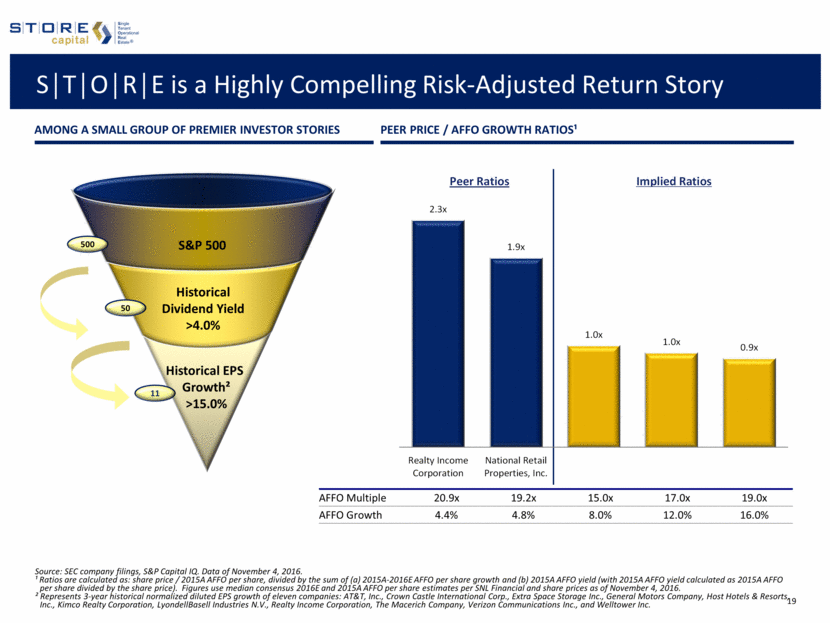
Margins of safety are built into everything we do. STORE’s Many Margins of Safety contract quality Approximately 75% investment-grade Master leases 80% of the time Investments average 82% of replacement cost Investment yields above NAV auction yields Portfolio characteristics Unparalleled direct investment origination platform, with 90% of our contracts prepared by us and over 75% of our customer relationships directly solicited Over 1,575 profit-center properties leased to nearly 340 tenants, across 48 states and 100 industries A top exposure of 2.3% of rent and interest income, with top ten tenants at less than 17% and over 80% of our portfolio under 1% Seasoned tenants with median annual revenues approximating $44 million and weighted average revenues in excess of $690 million Portfolio monitoring Virtually all tenants provide financial statements 97% property-level financial statements Every investment independently appraised ~15% annual physical portfolio inspection Financial strength A highly protected dividend High contract lease escalations Multiple investment-grade borrowing options Conservative leverage and flexible balance sheet Organizational structure Credit and closing silos Management and Board Investment Committees
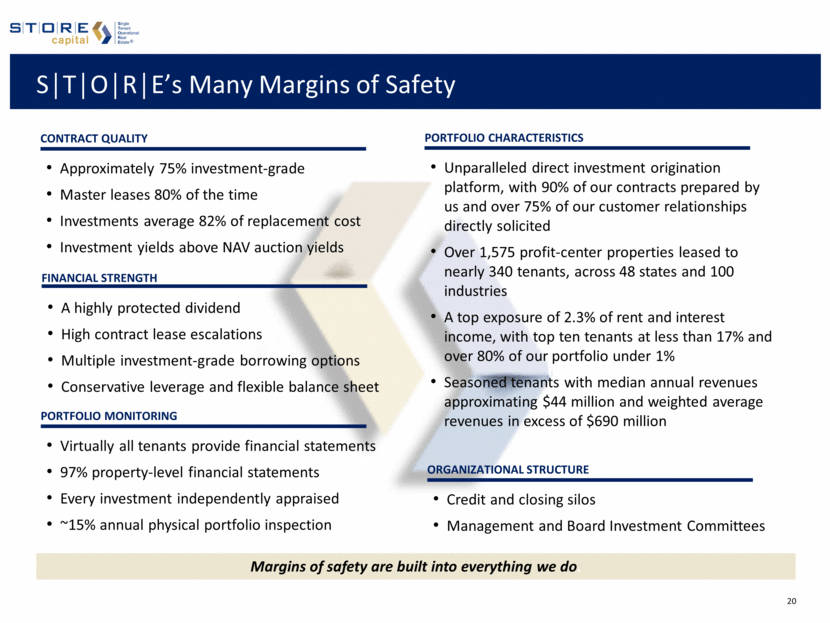
Investment Highlights We own a high quality, predominantly investment-grade quality, net-lease contract portfolio 2 We believe we employ a market-leading, direct origination approach in an underserved $2.5 trn market 1 Our leadership team has a 35-year track record of out-performance1 6 4 Our business model is positioned to deliver dividends and dividend growth 5 We build margins of safety for our shareholders in everything we do Our differentiated capital markets strategy is designed to achieve an ideal capital structure 3 1 Based on annualized total returns earned by management’s prior investment vehicles while operating as a public company, compared to annualized total returns on the MSCI US REIT Index during the same periods. The past performance of these investment vehicles is not an indicator of S T O R E’s future performance, and S T O R E’s performance may be significantly less favorable than the past performance data included in this presentation. Moreover, some of the past performance data covers periods with economic characteristics and cycles and interest rate environments that are significantly different from those S T O R E faces today and may face in the future.
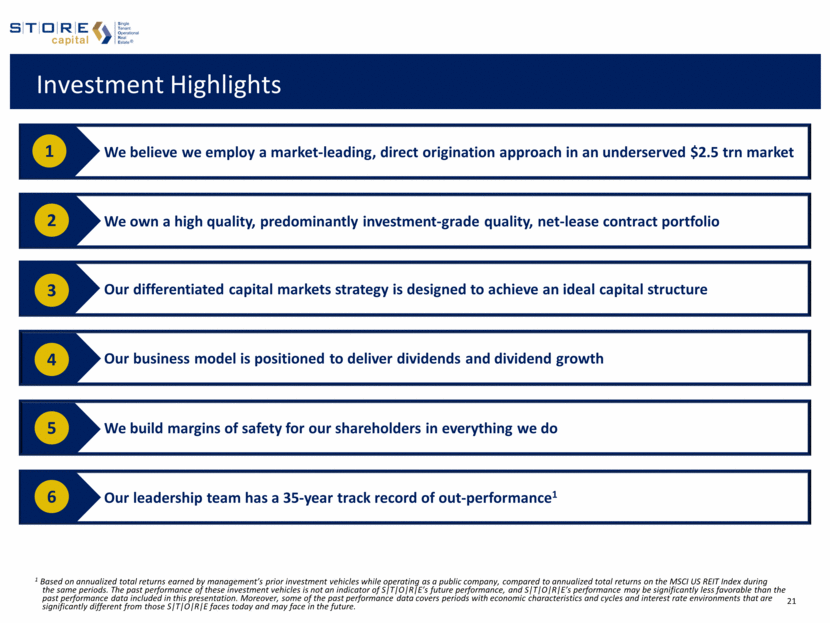
Appendix
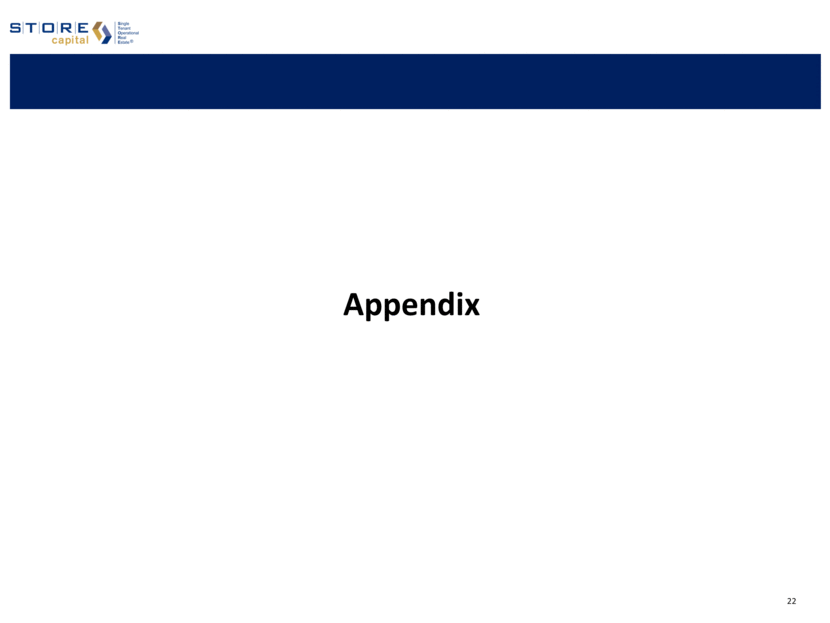
Definitions and Footnotes 1 Weighted average annual lease escalation represents the weighted average annual escalation rate of the entire portfolio as if all escalations occurred annually. For escalations based on a formula including CPI, assumes the stated fixed percentage in the contract or assumes 1.5% if no fixed percentage is in the contract. For contracts with no escalations remaining in the current lease term, assumes the escalation in the extension term. Calculation excludes contracts representing less than 0.3% of annualized base rent and interest where there are no further escalations remaining in the current lease term and there are no extension options. 2 S T O R E defines occupancy as a property being subject to a lease or loan contract. 3 The number of properties not currently operating but subject to a lease represents the number of our investment locations that have been closed by the tenant but remain subject to a lease. 4 The percentage of investment portfolio subject to master leases represents the percentage of the investment portfolio in multiple properties with a single customer subject to master leases. Based on annualized base rent and interest, 81% of the investment portfolio involves multiple properties with a single customer, whether or not subject to a master lease. 5 The average investment amount/replacement cost (new) represents the ratio of purchase price to replacement cost (new) at acquisition. 6 S T O R E calculates unit fixed charge coverage ratio generally as the ratio of (i) the unit’s EBITDAR, less a standardized corporate overhead expense based on estimated industry standards, to (ii) the unit’s total fixed charges, which are its lease expense, interest expense and scheduled principal payments on indebtedness. The 4-Wall coverage ratio refers to a unit’s FCCR before taking into account standardized corporate overhead expense. 7 The proportion of investment contracts rated investment grade represents the percentage of our contracts that have a STORE Score that is investment grade. We measure the credit quality of our portfolio on a contract-by-contract basis using the STORE Score, which is a risk measure reflective of both the credit risk of our tenants and the profitability of the operations at the properties. See Slide 10
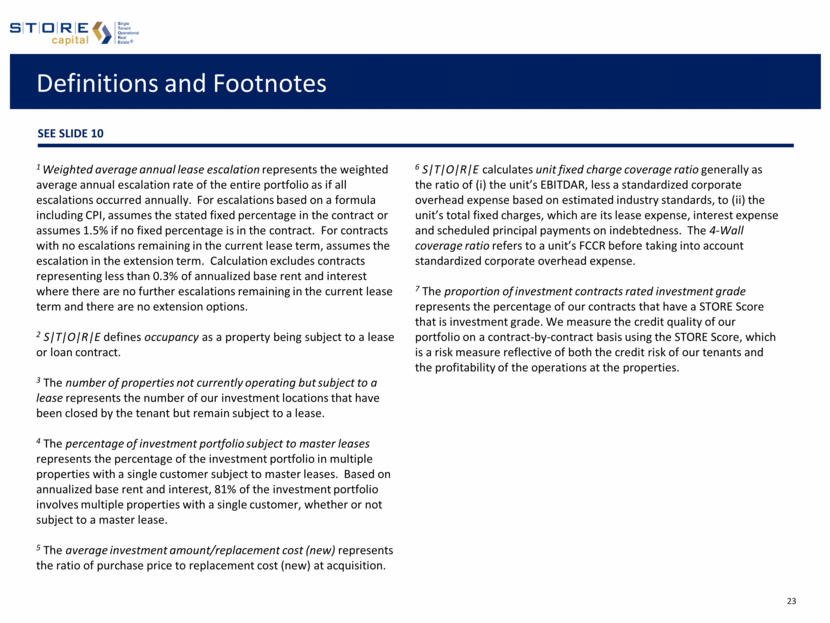
Supplemental Reporting Measures Funds from Operations, or FFO, and Adjusted Funds from Operations, or AFFO Our reported results are presented in accordance with U.S. generally accepted accounting principles, or GAAP. We also disclose Funds from Operations, or FFO, and Adjusted Funds from Operations, or AFFO, both of which are non-GAAP measures. We believe these two non-GAAP financial measures are useful to investors because they are widely accepted industry measures used by analysts and investors to compare the operating performance of REITs. FFO and AFFO do not represent cash generated from operating activities and are not necessarily indicative of cash available to fund cash requirements; accordingly, they should not be considered alternatives to net income as a performance measure or to cash flows from operations as reported on a statement of cash flows as a liquidity measure and should be considered in addition to, and not in lieu of, GAAP financial measures. We compute FFO in accordance with the definition adopted by the Board of Governors of the National Association of Real Estate Investment Trusts, or NAREIT. NAREIT defines FFO as GAAP net income, excluding gains (or losses) from extraordinary items and sales of depreciable property, real estate impairment losses and depreciation and amortization expense from real estate assets, including the pro rata share of such adjustments of unconsolidated subsidiaries. To derive AFFO, we modify the NAREIT computation of FFO to include other adjustments to GAAP net income related to certain non-cash revenues and expenses such as straight-line rents, amortization of deferred financing costs and stock-based compensation. In addition, in deriving AFFO, we exclude transaction costs associated with acquiring real estate subject to existing leases and certain other expenses not related to our ongoing operations. FFO is used by management, investors and analysts to facilitate meaningful comparisons of operating performance between periods and among our peers primarily because it excludes the effect of real estate depreciation and amortization and net gains on sales, which are based on historical costs and implicitly assume that the value of real estate diminishes predictably over time, rather than fluctuating based on existing market conditions. Management believes that AFFO provides more useful information to investors and analysts because it modifies FFO to exclude certain additional non-cash revenues and expenses such as straight-line rents, amortization of deferred financing costs and stock-based compensation as such items may cause short-term fluctuations in net income but have no impact on operating cash flows or long-term operating performance. Additionally, in deriving AFFO, we exclude transaction costs associated with acquiring real estate subject to existing leases. We view transaction costs to be a part of our investment in the real estate we acquire, similar to the treatment of acquisition and closing costs on our sale-leaseback transactions, which are capitalized as a part of the investment in the asset. We believe that transaction costs are not an ongoing cost of the portfolio in place at the end of each reporting period and, for these reasons, we add back the portion expensed when computing AFFO. Similarly, in 2016 we excluded the offering expenses incurred on behalf of our selling stockholder, STORE Holding, when it exited all of its holdings of STORE Capital common stock, as those costs are not related to our ongoing operations. As a result, we believe AFFO to be a more meaningful measurement of ongoing performance that allows for greater performance comparability. Therefore, we disclose both FFO and AFFO and reconcile them to the most appropriate GAAP performance metric, which is net income. STORE Capital’s FFO and AFFO may not be comparable to similarly titled measures employed by other companies.
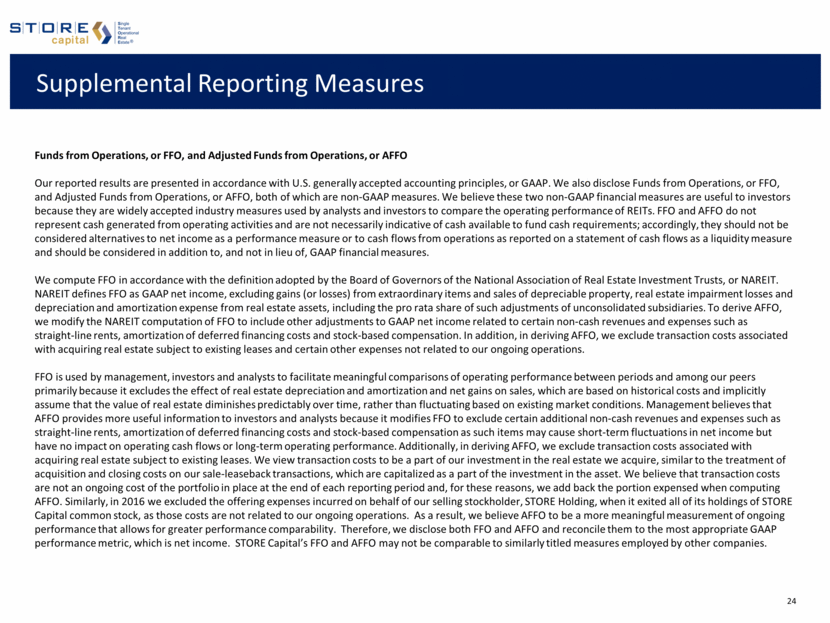
Supplemental Reporting Measures (Continued) EBITDA, Adjusted EBITDA, Annualized Adjusted EBITDA and Adjusted Debt EBITDA represents earnings before interest, taxes, depreciation and amortization. Adjusted EBITDA represents EBITDA modified to include other adjustments to GAAP net income for transaction costs, non-cash impairment charges and gains/losses on dispositions of real estate and certain other expenses not related to ongoing operations. Annualized Adjusted EBITDA is calculated by multiplying Adjusted EBITDA for the quarter by four. Annualized Adjusted EBITDA – Current Estimated Run Rate is calculated based on an estimated Adjusted EBITDA as if all leases and loans in place as of September 30, 2016 had been in place as of July 1, 2016; then annualizing the Adjusted EBITDA for the quarter by multiplying it by four. You should not unduly rely on this metric as it is based on several assumptions and estimates that may prove to be inaccurate. Our actual reported Adjusted EBITDA for future periods may be significantly less than that implied by our reported Annualized Adjusted EBITDA – Current Estimated Run Rate for a variety of reasons. Adjusted Debt represents our outstanding debt obligations excluding unamortized deferred financing costs and net debt premium, further reduced for cash and cash equivalents and restricted cash deposits held for the benefit of lenders. We believe excluding unamortized deferred financing costs and net debt premium, cash and cash equivalents and restricted cash deposits held for the benefit of lenders provides an estimate of the net contractual amount of borrowed capital to be repaid which we believe is a beneficial disclosure to investors and analysts. Adjusted Debt to Annualized Adjusted EBITDA Adjusted Debt to Annualized Adjusted EBITDA, or leverage, is a supplemental non-GAAP financial measure we use to evaluate the level of borrowed capital being used to increase the potential return of our real estate investments. We calculate leverage by dividing Adjusted Debt by Annualized Adjusted EBITDA. Because our portfolio growth level is significant to the overall size of the Company, we believe that presenting this leverage metric on a run rate basis is more meaningful than presenting the metric for the historical quarterly period, and we refer to this metric as Adjusted Debt to Annualized Adjusted EBITDA—Current Estimated Run Rate. Leverage should be considered as a supplemental measure of the level of risk to which stockholder value may be exposed. Our computation of leverage may differ from the methodology employed by other companies, and, therefore, may not be comparable to other measures.
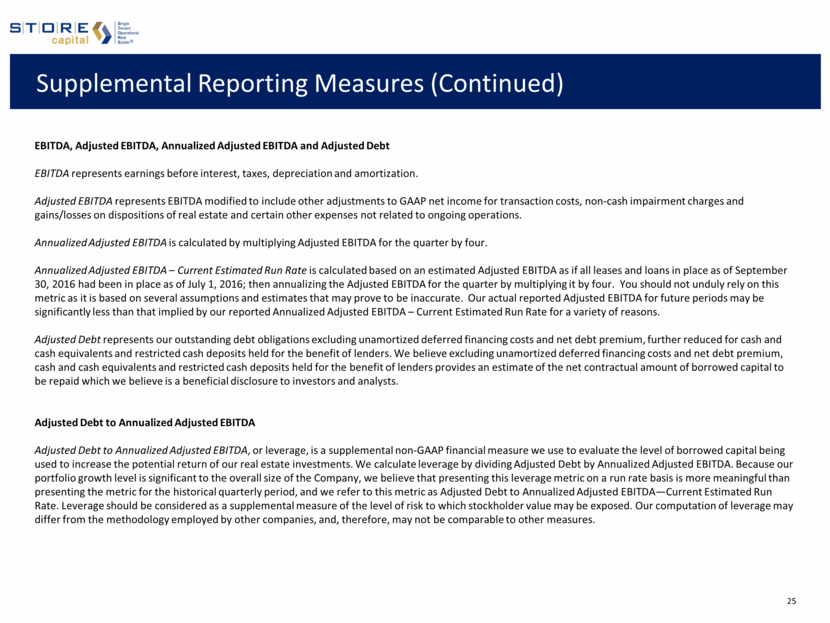
GAAP Reconciliations: Net Income to NOI Note: Columns may not sum due to rounding effects. Year Ended December 31, Nine Months Ended September 30, $ millions 2013 2014 2015 2015 2016 Net Income $ 26.3 $ 48.1 $ 83.8 $ 59.7 $ 91.4 Less: Gain on dispositions of real estate - (4.5) (1.3) (1.9) (9.5) Less: income from discontinued operations, net of tax (4.0) (1.1) - - - Income from Continuing Operations $ 22.3 $ 42.5 $ 82.4 $ 57.8 $ 81.9 Adjustments: Income tax expense 0.2 0.2 0.3 0.2 0.2 Depreciation and amortization 30.3 57.0 88.6 63.7 86.6 General and administrative 14.1 19.5 28.0 21.0 25.2 Transaction costs 2.6 2.8 1.2 1.0 0.5 Interest 39.2 68.0 81.8 59.3 76.4 Selling stockholder costs - - - - 0.8 Provision for impairment of real estate - - 1.0 1.0 - Net Operating Income $ 108.8 $ 190.0 $ 283.2 $ 204.0 $ 271.7
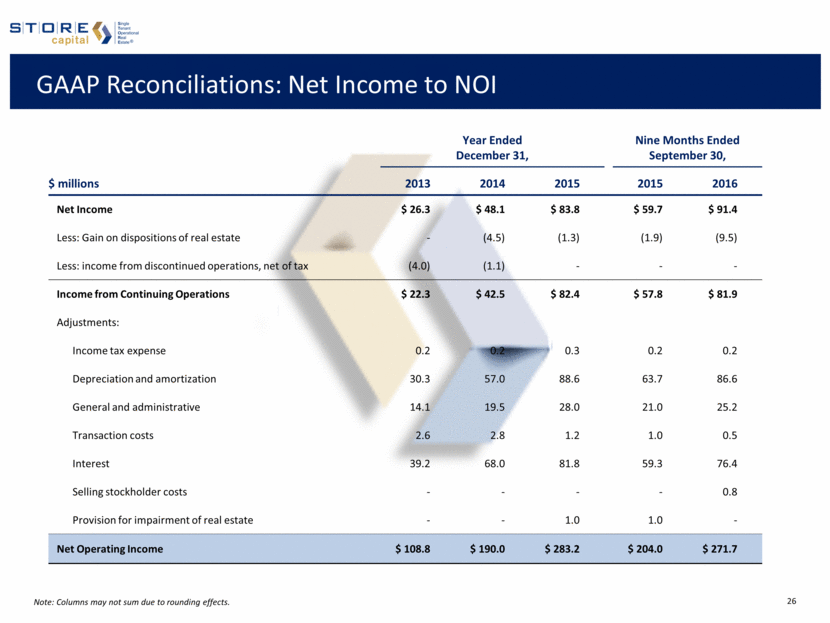
GAAP Reconciliations: Net Income to FFO and AFFO Note: Columns may not sum due to rounding effects. Year Ended December 31, Nine Months Ended September 30, $ millions 2013 2014 2015 2015 2016 Net Income $ 26.3 $ 48.1 $ 83.8 $ 59.7 $ 91.4 Depreciation and amortization of real estate assets: Continuing operations 30.1 56.7 88.3 63.5 86.2 Discontinued operations 0.6 - - - - Provision for impairment of real estate - - 1.0 1.0 - Gain on dispositions of real estate, net of tax (2.2) (5.5) (1.3) (1.9) (9.5) Funds From Operations $ 54.8 $ 99.4 $ 171.7 $122.3 $168.1 Adjustments: Straight-line rental revenue, net (1.4) (2.4) (2.0) (1.5) (2.5) Transaction costs 2.6 2.8 1.2 1.0 0.5 Non-cash equity-based compensation 1.2 2.3 4.7 3.4 5.2 Non-cash interest expense 4.2 7.1 6.5 4.8 5.3 Amortization of lease-related intangibles and costs 0.3 0.7 1.4 0.8 1.3 Selling stockholder costs - - - - 0.8 Adjusted Funds From Operations (AFFO) $ 61.7 $ 109.9 $ 183.5 $ 130.9 $ 178.7
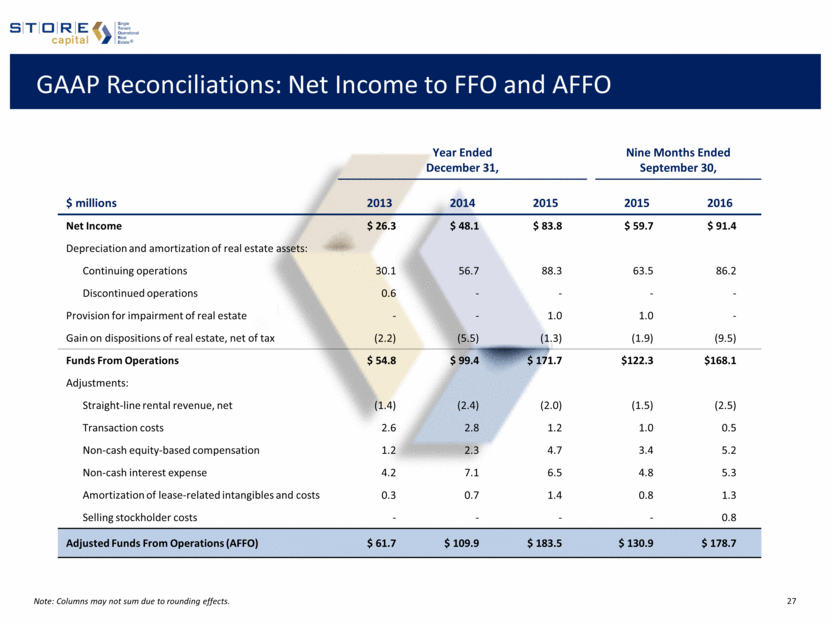
GAAP Reconciliations: Debt to Adj. Debt and Net Income to Adj. EBITDA $ millions As of September 30, 2016 Debt $ 2,158.2 Adjustments: Unamortized net debt discount 0.2 Unamortized deferred financing costs 34.3 Cash and cash equivalents (30.0 ) Restricted cash deposits held for the benefit of lenders (41.1 ) Adjusted Debt $ 2,121.5 $ millions Three Months Ended September 30, 2016 Net income $ 36.3 Adjustments: Interest 27.1 Depreciation and amortization 31.1 Income tax expense 0.1 EBITDA $ 94.7 Adjustments: Transaction costs 0.2 Gain on dispositions of real estate, net of tax (6.7) Adjusted EBITDA $ 88.1 Estimated additional Adjusted EBITDA for the quarter had all leases and loans in place as of September 30, 2016 been in place as of July 1, 2016 2.0 Adjusted EBITDA – Current Estimated Run Rate $ 90.1 Annualized Adjusted EBITDA – Current Estimated Run Rate $ 360.5 Adjusted Debt / Annualized Adjusted EBITDA – Current Estimated Run Rate 5.9 x Note: Columns may not sum due to rounding effects.
